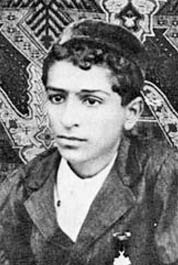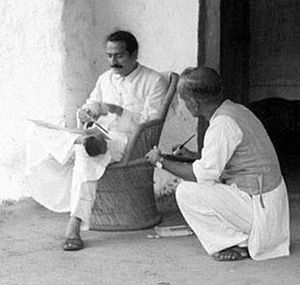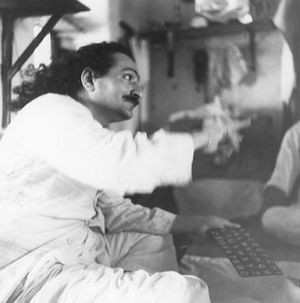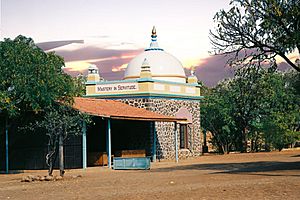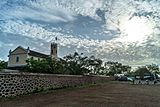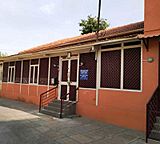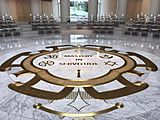Meher Baba facts for kids
Quick facts for kids
Meher Baba
|
|
|---|---|
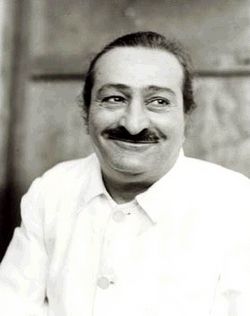
Meher Baba in 1945
|
|
| Born |
Merwan Sheriar Irani
25 February 1894 |
| Died | 31 January 1969 (aged 74) |
| Other names | The Awakener |
|
Notable work
|
God Speaks, Discourses |
|
Main interests
|
Religion, metaphysics, aesthetics, ethics |
|
Influences
|
|
| Signature | |
 |
|
Meher Baba (born Merwan Sheriar Irani; 25 February 1894 – 31 January 1969) was an Indian spiritual teacher. He believed he was the Avatar, a special human form of God, for his time. He became a very important spiritual leader in the 20th century. He had many followers, especially in India, but also in the United States, Europe, and Australia.
Meher Baba's ideas about how our minds work combined teachings from different spiritual paths. These included Sufi, Vedic, and Yogic traditions. He taught that everyone's main goal is to realize they are connected to God. He believed that all of us are part of one divine being.
When he was 19, Meher Baba started a seven-year journey of spiritual growth. During this time, he met several important spiritual figures. In 1925, he began a 44-year period of silence. He first communicated using an alphabet board. By 1954, he used only hand gestures with an interpreter. He passed away in 1969 and was buried in Meherabad. His tomb is now a special place where his followers, often called "Baba lovers," go to visit.
Contents
Understanding Meher Baba's Teachings
Meher Baba's teachings focused on the meaning and purpose of life. He explained that the world we see is like an illusion. He taught that the entire Universe is like an imagination. He believed that only God truly exists. Each soul is God, going through this imagination to realize its own divine nature.
He gave advice to his followers who wanted to achieve "God-realization." This means understanding their true connection to God. He also talked about "Perfect Masters" and the "Avatar." These are special spiritual guides. His most important books were God Speaks and Discourses. For many years, he chose not to speak. Later, he also stopped communicating through writing. This practice of silence is still discussed among his followers.
Meher Baba's Impact on Culture
Meher Baba's influence spread widely. He created the Avatar Meher Baba Charitable Trust in India. This trust runs centers for information and pilgrimage. He also influenced many people in pop culture. He is known for the common phrase "Don't worry; be happy." This phrase was used in Bobby McFerrin's famous 1988 song.
Many well-known musicians became his followers. These included Melanie Safka and Pete Townshend. Journalists like Sir Tom Hopkinson also followed him. In the 1970s, his followers in the United States grew. Some people believe his movement was larger than others at the time. He identified as a Sufi, a follower of a mystical Islamic path. He was seen as a leader of Western Sufism.
Meher Baba's Life Journey
Early Years and Spiritual Awakening
Meher Baba was born in 1894 in Pune, India. His birth name was Merwan Sheriar Irani. His parents were Irani Zoroastrians. His father, Sheriar Irani, had traveled seeking spiritual experiences.
As a boy, Merwan was very active. He started a club called the Cosmopolitan Club. This club focused on world events and giving to charity. He played many musical instruments and wrote poetry. He spoke several languages and loved the poems of Hafez, William Shakespeare, and Percy Bysshe Shelley.
His spiritual journey began when he was 19. It lasted for seven years. He met an elderly Muslim saint named Hazrat Babajan. She kissed him on the forehead. This caused him to enter a nine-month-long trance. He described it as "divine bliss." Babajan predicted he would become a spiritual leader. He then met Upasni Maharaj. Meher Baba later said Maharaj helped him understand his spiritual experiences. This allowed him to live a normal life while still feeling connected to God.
Over the next few years, he met other spiritual figures. These included Tajuddin Baba, Narayan Maharaj, and Sai Baba of Shirdi. Meher Baba later called these five, along with Babajan and Upasni Maharaj, the "Perfect Masters" of their time. By 1922, at age 27, Meher Baba began to gather his own students. They gave him the name Meher Baba, meaning "compassionate father."
In 1922, Meher Baba and his followers created Manzil-e-Meem (House of the Master) in Bombay (now Mumbai). There, Baba began to ask for strict discipline from his students. A year later, Baba and his mandali (circle of disciples) moved. They went to an area near Ahmednagar that he named Meherabad (Garden of Blessing). This ashram (spiritual retreat) became the main place for his work. In the 1920s, Meher Baba opened a free school, hospital, and clinic at Meherabad. These were open to everyone, no matter their caste or faith.
From July 10, 1925, until his death, Meher Baba remained silent. He spent long periods alone with his mandali. During these times, he often fasted. He also traveled widely, held public meetings, and helped lepers and the poor. He first communicated using chalk and a slate. Then he used an alphabet board. Later, he used a special set of hand gestures. On December 1, 1926, he wrote his last message. After that, he relied only on the alphabet board.
Connecting with the West (1930s)
Starting in 1931, Meher Baba began visiting Western countries. He made several trips to Europe and the United States. During this time, he met his first close Western followers. He traveled using a Persian passport. He had stopped writing and speaking, so he would not sign the forms needed by the British government. He gained more followers during these trips. In the 1940s, Meher Baba worked with spiritual seekers called masts. He said these individuals were deeply absorbed in spiritual experiences.
On his first trip to England in 1931, he traveled on the SS Rajputana. Mahatma Gandhi was also on this ship, going to a conference in London. Baba and Gandhi met three times. One meeting lasted three hours. The British newspapers reported these meetings.
In the West, Meher Baba met many famous people. These included Gary Cooper, Charles Laughton, and Boris Karloff. In 1932, Mary Pickford and Douglas Fairbanks, Jr. hosted a reception for Baba in Hollywood. He gave a message to the Hollywood community. Because of this, Meher Baba became very popular in the 1930s.
In 1934, Baba announced he would break his silence in the Hollywood Bowl. But he suddenly changed his plans. He sailed to Hong Kong without explanation. The news reported that he decided to wait because "conditions are not yet ripe." He returned to England in 1936. He did not visit the United States again until the early 1950s.
In the late 1930s, Meher Baba invited a group of Western women to India. He arranged trips for them across India and British Ceylon. These trips were called the Blue Bus Tours. When they returned home, many newspapers reported their journey as a scandal.
Working with Masts and the "New Life" (1940s)
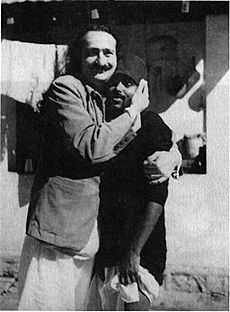
In the 1930s and 1940s, Meher Baba spent a lot of time with masts. According to Baba, these people were deeply affected by their spiritual experiences. Even if they seemed confused or unwell to others, Baba said their spiritual status was very high. He believed that by meeting them, he helped them spiritually. One famous mast, Mohammed Mast, lived at Meherabad until he passed away in 2003.
In 1949, Baba began a mysterious period he called the "New Life." He asked 20 companions if they were ready to obey his most difficult requests. He made sure those who depended on him were cared for. Then, he and his companions gave up almost all their belongings and money. They traveled across India without being recognized. They begged for food and followed Baba's strict rules for the "New Life." These rules included accepting any situation and staying cheerful no matter what. Companions who did not follow these rules were sent away.
Meher Baba ended the New Life in February 1952. He then began making public appearances again in India and the West.
Later Years and Accidents (1950s)
Meher Baba was a passenger in two serious car accidents. One happened near Prague, Oklahoma in the United States in 1952. The other was in India in 1956. After these accidents, his ability to walk became very limited.
In the 1950s, Baba opened two centers outside India. These were the Meher Spiritual Center in Myrtle Beach, South Carolina, USA, and Avatar's Abode near Brisbane, Australia. He opened the Meher Spiritual Center in April 1952. On May 24, 1952, his car was hit head-on near Prague, Oklahoma. He and his companions were thrown from the car. Baba's leg was badly broken, and he had face injuries. They were treated at Duke Hospital. While recovering, he worked on the rules for a Sufi group called Sufism Reoriented.
Meher Baba started dictating his main book, God Speaks, The Theme of Creation and Its Purpose, in August 1953. He used an alphabet board. In September 1954, Meher Baba held a meeting for men only at Meherabad. This event became known as the Three Incredible Weeks. During this time, Baba declared that he was the Avatar. He gave the finished book God Speaks to two members of Sufism Reoriented for publishing. The book was published the next year.
In October 1954, Meher Baba stopped using his alphabet board. He began using a special set of hand gestures to communicate. He used these gestures for the rest of his life.
On December 2, 1956, another serious car accident happened near Satara, India. Baba's car went out of control. He suffered a fractured pelvis and other severe injuries. This accident greatly affected him. Even though doctors thought he might not walk again, Baba worked hard and did. But from then on, he was in constant pain. He had very limited movement. During his trip to the West in 1958, he often had to be carried.
His last visits to the United States and Australia were in 1958.
Passing and Legacy
Meher Baba passed away on January 31, 1969, at his home in Meherabad. He was almost 75 years old. With his last gestures, he conveyed, "Do not forget that I am God." His followers call the anniversary of his death Amartithi (deathless day). Meher Baba's body was placed at his samadhi (tomb) at Meherabad. It was covered with roses and kept cool with ice. His body was available for public viewing for one week before his burial. Before his death, Meher Baba had planned a public gathering in Poona. His followers decided to go ahead with it. Thousands attended this "Last Darshan."
Meher Baba's Silence
From July 10, 1925, until his death in 1969, Meher Baba remained silent. He first used an alphabet board to communicate. Later, he used unique hand gestures. One of his disciples, Eruch Jessawala, would interpret and speak his messages. Meher Baba said his silence was not a spiritual exercise for himself. Instead, it was connected to his work for the whole world.
Meher Baba often hinted that he would "break" his silence. He said he would speak the "Word" in everyone's heart. This would give a spiritual push to all living things. He believed that when he broke his silence, it would be a very important event for the world's spiritual growth.
Meher Baba promised many times to speak an audible word before he died. He often gave specific times and places. However, he remained silent until his death. Some followers were disappointed by this. Others saw these broken promises as a test of their faith. Some followers believe that "the Word" will still be "spoken." Others think Meher Baba broke his silence in a spiritual way, not a physical one.
For many years, Baba asked his followers to observe silence on July 10. This was the anniversary of the day his silence began. He also asked them to fast and pray. In 1968, his last request for Silence Day was only that they keep silent. Many followers still celebrate Silence Day by remaining silent in his honor.
Key Teachings of Meher Baba
Meher Baba's teachings can be divided into two main parts. One part is his ideas about the nature of the soul and the Universe. The other part is practical advice for people on a spiritual path. These two parts are connected. His ideas about the Universe are mostly found in his book God Speaks. This book explains his views on how the Universe was created and the purpose of life. It also describes the journey of the soul. His advice for spiritual living is mostly in Discourses.
Understanding God Speaks
In God Speaks, Meher Baba describes the soul's journey. It starts in a state of unconscious divinity. It ends with the soul becoming fully aware of its divine nature. He says this whole journey is like an imagination. The original, undivided state of God imagines becoming countless individual souls. He compares these souls to bubbles in a huge ocean. Each soul wants to become aware. It starts its journey in the simplest form of consciousness. This limited awareness makes it need more developed forms to grow.
According to Baba, each soul seeks conscious divinity by evolving. This means it experiences itself in a series of imagined forms. These forms go through seven "kingdoms": stone/metal, vegetable, worm, fish, bird, animal, and human. The soul identifies with each form. This ties it to the illusion of the world. As forms evolve, the power of thought increases. In human form, thought becomes infinite. Even though a human soul can achieve conscious divinity, all the experiences it gathered during evolution are illusions. These illusions create a barrier. To overcome this barrier, the soul needs more births in human form. This process is called reincarnation.
The soul will reach a point where its past experiences become weaker. Then, it enters a final stage called involution. This stage also requires several human births. During this time, the soul begins an inner journey. It starts to realize its true identity as God. Baba divides this inner journey into seven stages, or "planes." The journey ends at the seventh plane with God-realization. At this point, the soul reaches its life's goal.
Insights from Discourses
The Discourses are a collection of explanations from Meher Baba. They cover many topics that help a spiritual seeker. Some important topics include: sanskaras (mental impressions), Maya (the principle of illusion), the nature of the ego, reincarnation, karma, violence, non-violence, meditation, love, and God-realization. His explanations often include stories from Indian and Sufi traditions. For example, the story of the wise man and the ghost shows how superstitious beliefs can affect a person. Another story, Majnun and Layla, shows how selfless love can lead to spiritual devotion.
Meher Baba offers many suggestions to help one move towards God-realization. These include putting spiritual ideas into practice. They also involve giving up desires internally. He suggests offering selfless service to others or to a spiritual master. He encourages spontaneity. He advises avoiding actions that tie one to illusion. Instead of just giving moral rules, Baba helps people understand why some actions limit them and others help them become free. Many chapters explain how consciousness gets caught between opposites, like pleasure and pain, good and evil. They also show a way to go beyond these opposites.
Perfect Masters and the Avatar
Baba taught that there are always 56 God-realized souls living on Earth. Among these, five are always the "Perfect Masters" of their time. When one Perfect Master passes away, another God-realized soul from the 56 takes their place.
The Avatar, according to Baba, is a very special Perfect Master. This is the first soul to ever achieve God-realization. This original Perfect Master, or Ancient One, always continues to be born into human form. Baba said this soul represents the state of God called Vishnu in Hinduism and Parvardigar in Sufism. This is the God who sustains or preserves everything. The Avatar, Baba claimed, appears on Earth every 700–1400 years. The five Perfect Masters of that time bring the Avatar into human form. This is to help creation on its never-ending journey toward Godhood. Baba stated that in the past, this role was filled by Zoroaster, Rama, Krishna, Buddha, Jesus, and Muhammad.
Baba described the Avatar as "a guide against which man can measure what he is and what he may become." The Avatar helps set the standard for human values. Most of Meher Baba's followers accept his claim of being the Avatar. He is "revered by millions around the world as the Avatar of the age."
Meher Baba's Legacy
Meher Baba's travels and teachings created a legacy of followers worldwide.
The Avatar Meher Baba Charitable Trust was started by Meher Baba in 1959. It takes care of his tomb and pilgrimage sites. It also runs a free school and clinic, a cataract clinic, and an animal clinic. The Trust follows the rules Meher Baba set during his life. It does not act as a spiritual authority over groups. The Trust also does not try to convert people or promote specific beliefs. Baba did not encourage trying to get new followers. He said, "I need no propaganda or publicity." Instead, he encouraged his followers to "let your life itself be my message of love and truth to others." He also asked them to "spread my message of Love and Truth as far and wide as possible." Meher Baba's followers do not have set rituals. Many choose to do things like pujas (worship), aartis (light ceremonies), prayers, and music. The main goal for followers is to live a life that Meher Baba would approve of.
Gatherings of Baba followers are usually informal. They make a special effort to meet on Amartithi, the anniversary of his death. They also gather on his birthday. Many followers observe silence on July 10 (Silence Day). This honors Baba's request during his lifetime. Aarti is performed every morning and evening at Baba's samadhi in India. Also at Meherabad, his followers continue Baba's practice of lighting a dhuni (sacred fire) on the 12th of each month.
Baba gained public attention in the West as early as 1932. This was due to his meetings with famous people. He also received attention after his death through mentions in Western pop culture.
Pete Townshend of the Who became a follower of Baba. He dedicated his 1969 rock opera Tommy to him. The Who's 1971 song "Baba O'Riley" was partly named after Meher Baba. Townshend also recorded several albums honoring Meher Baba.
In 1970, Melanie Safka (known as "Melanie") mentioned Baba in her song "Lay Down (Candles in the Rain)". The lyrics say, "Meher Baba lives again."
Bobby McFerrin's 1988 Grammy Award-winning song "Don't Worry, Be Happy" was inspired by Baba's saying. This saying has appeared on many posters and cards featuring him.
Ideas from Meher Baba's philosophy have appeared in the works of comic book writer J. M. DeMatteis. Works like Doctor Fate and Seekers into the Mystery were influenced by Baba.
In 2012, the film Nema Aviona za Zagreb premiered. It included an exclusive interview with Meher Baba filmed in 1967.
Major Centers of Pilgrimage
-
Upper Meherabad, near Ahmednagar, India
-
Meher Baba's House in Pune, India
-
Universal Spiritual Center in Byramangala, Karnataka, India
-
Meher Baba's Manonash Cave in Khajaguda, Hyderabad, India
-
Meher Spiritual Center Entrance in Myrtle Beach, South Carolina, USA
-
Meher Baba Heartland center in Prague, Oklahoma, USA
-
Meher Mount Center in Sulphur Mountain, Ojai, California, USA
-
Sufism Reoriented Sanctuary in Walnut Creek, California, USA
-
The Avatar's Abode in Kiels Mountain, Queensland, Australia
See also
 In Spanish: Meher Baba para niños
In Spanish: Meher Baba para niños


